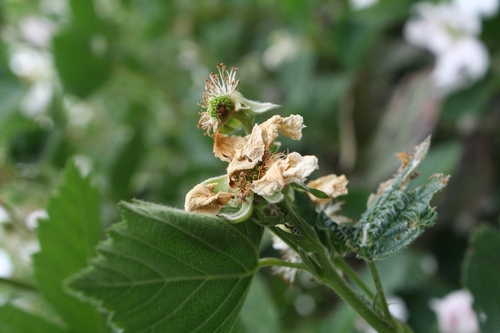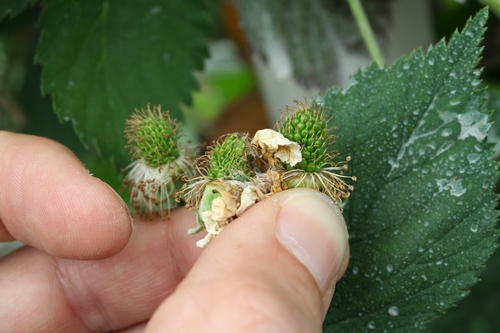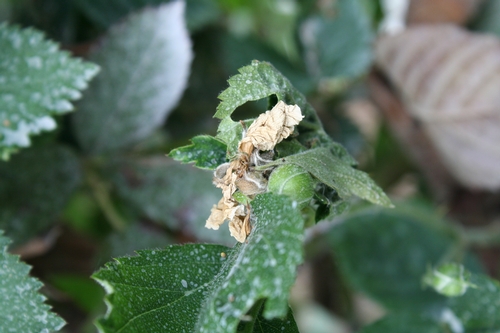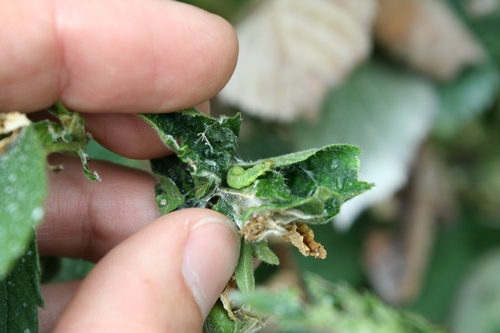
A Review on Managing LBAM in Watsonville
Blackberry growers in the Pajaro Valley should be aware that there are substantial numbers of light brown apple moth (LBAM) larvae active in many fields right now. The photos below outline what this pest looks like and what it is doing right now in our blackberry fields.
In the photographed field, there were on the order of 7-9 leafrolls per two feet of hedge in the heaviest infested areas and in excess of 80% of the leafrollers sampled in the photographed field were identified as having a very high likelihood of being LBAM. This is very concerning, since under the current quarantine enforced by the USDA, the presence of any leafroller in a field can be cause for significant delay of harvest much less outright field closure if an LBAM is found.
While clearly not the level of devastating 100% loss of harvest caused by field closure for a positive LBAM find, LBAM itself is also capable of causing some damage. As one can see from the photos below, damage ranges from incidental feeding on flowers resulting in blemished (thus unmarketable) fruit to heavier feeding causing abortion of entire laterals and the subsequent loss of fruiting potential there. In the field photographed below there was damage of some sort to one of every sixteen fruiting laterals.
Anecdotally, it appears that growers who kept up with changing out pheromone based twist ties every four to six months have very low populations of LBAM suspect leafrolls, while those who allowed pheromone coverage to expire before putting up a fresh set are tending to have heavier, in some cases very heavy, larval infestations. If one is not going to be using pheromone based twist ties through the entire year, it is at least a good idea to put out a few pheromone traps to find out when adult males are starting to fly and looking to mate so as to better target use of mating disruption techniques.
As it seems many of the larvae being discovered currently are in the fourth to late instar stage (½ to ¾ inches in length), applications of Bacillus thuriengiensis formulations will not prove to be very effective. Better materials are the spinosyns, one of which (Entrust) is registered for use in organic fields, and bifenthrin (hard on beneficials though). Addition of a good surfactant is always a good idea to break spray water surface tension to facilitate movement of material into even the tightliest wound leafroll.
There are several insecticides mentioned for control of light brown apple moth in this article. Before using any insecticides, check with your local Agricultural Commissioner's Office and consult product labels for current status of product registration, restrictions, and use information.

Flower destroyed by leafroller- note damaged immature fruit at top- once blemished like this it will not make properly

Flower and adjacent fruit destroyed by leafroller

Fruit lateral destroyed by leafroller

Leafroller emerging from destroyed lateral
Comments:
You're not too confident with the pictures and data in the blog I take it. I'll tell you for one thing it wasn't this heavy last year and yes there is reason for concern, hence my posting.
As to your assertion that LBAM has been here for 50 years, that idea has been batted around the CA entomology community by some pretty heavy hitters for some time, but the scientist who found the first LBAM in California, Dr. Jerry Powell, maintains this is not true. At a seminar concerning LBAM at the Entomological Society of America meeting last December in San Diego attended by some 200 people (you should have been there, it was one of the best scientific seminars I have attended in a long time), he underlined that his trapping program has been going on for decades and is done in targeted, sustained manner. He is not some hobbyist collecting butterflies on sunny afternoons. He really emphasized that he would have found LBAM if it had been here for 50 years. Even so, no doubt there were people in the audience who still disputed the assertion that Dr. Powell found one of the early entrants several years ago, but such is the nature of scientific enquiry.
Have the larvae in this berry field been subjected to DNA testing, and, if so, what was the result?
Also, in regard to your response to Mr. Williams above and with great respect for Dr. Powell's expertise, are you aware of the National Academies of Science(NAS)/National Research Council's 2009 report on the LBAM program and in particular their critique of the state and federal survey and trapping program and data for LBAM? NAS concluded the following (the parenthetical references identify the page in USDA's response to LBAM reclassification petitions on which the NAS is commenting):
“‘Routine surveys’ by federal and state agencies at ports and nurseries (Response, p. 5) were not aimed specifically at LBAM before 2005, and the likelihood that LBAM would have been correctly identified is low because of limitations on taxonomic oversight. Similarly, the evidence that ‘specific surveys in the area where LBAM currently exists from the late 1950s to the present did not find this species’ (Response, p. 5) is based on trapping efforts conducted in specific locations in coastal California from 1960 onward that did not include either San Francisco or Santa Cruz, the two ‘hot spots’ from which LBAM appears to be spreading (USDA-APHIS, 2009). Moreover, the reference provided to support this evidence, attributed to Rubinoff and Powell, was not prepared by them, is unpublished, and is not accurately cited (Powell, pers. comm.). Thus, sufficient information is not available to allow a rigorous assessment of the true age of the LBAM invasion in California.” (p. 5)
Sincerely,
Nan Wishner
We field researchers can't do DNA analysis, since that can only be done by the CDFA lab which requires that the source field be identified so a positive means the field gets shut down and we become persona non grata with the grower that we were supposed to be helping. For us, ID is done on morphological characteristics such as number of anal combs, hence the "highly probable" language.
LBAM is a tough one because of all these issues with identification. That said, in the ten years or so that I've been at this work I've never seen this number of leafrollers around and you see from previous posts and the above that most do morphologically line up as being LBAM. Additionally, the near absence of leafrollers in fields where pheromone based mating disruption is being used properly (which as you know is pretty well specific to LBAM) point in that direction too.
That we are still operating under regulatory constraint only adds to my concern that growers not be negligent about the current leafroller infestation, which by all appearances is mostly LBAM.
Re your exchange with Mr. Robert Williams about the time of arrival of LBAM in California:
We now know that the CDFA has a Pest Detection Report (PDR) from 1997 in which they certify having found the Light Brown Apply Moth in California. Nevertheless, in March 2007, i.e. ten (10) years after that documented find by the CDFA, the CDFA declared a State of Emergency claiming that LBAM was first detected in California on February 27, 2007. Is this another "misrepresentation" by the CDFA on the subject of LBAM?
The reason the CDFA was forced to halt its "eradication" program for LBAM was because it was not based on the facts of LBAM's arrival in California nor on the science regarding its potential impact on our crops and native plants.
The heading of "LBAM on the march again Watsonville" on Mr. Bolda's blog is misleading and will doubtless lead some readers to the wrong conclusions about the impact of LBAM vs. native California leafrollers.
In this era of tightened budgets, why does the CDFA continue to penalize farmers with onerous quarantines and throw away tax-payer money on this non-threat to California agriculture?
Jane and Tom Kelly
Berkeley, CA

The entomologist who first noticed it, three courts who evaluated it, the state senate committee on agriculture all determined that the moth is a NON-ISSUE to agriculture.
Only the California Department of Agriculture (CDFA), the USDA, and the chemical companies who stood to rob taxpayers of $100 Million per year for unnecessary pesticide contracts are keeping this LBAM propaganda alive.
The quarantines & interference with farming are very real, but they are caused by CDFA, not LBAM.
Professor's press release on CDFA LBAM Program Fraud
http://www.indybay.org/newsitems/2008/10/07/18543314.php
After A.G. Kawamura discredited the CDFA and brought unnecessary conflict between farming and consumers related to LBAM, it is so disappointing that this new woman Secretary would still be beating the LBAM dead horse. Who exactly is CDFA's master? Is it one chemical pesticide company or a consortium?
There is NOT a single documented case of damage from LBAM at any Agriculture commissioner office in the State of California, NONE.
There are millions and millions of LBAM in Santa Cruz and San Francisco counties for six years since they were noticed and about 50 years since they arrived and not a single legitimate incident of crop damage or a single problem - END OF STORY.
Posted by RobertWilliams on April 21, 2011 at 9:48 AM